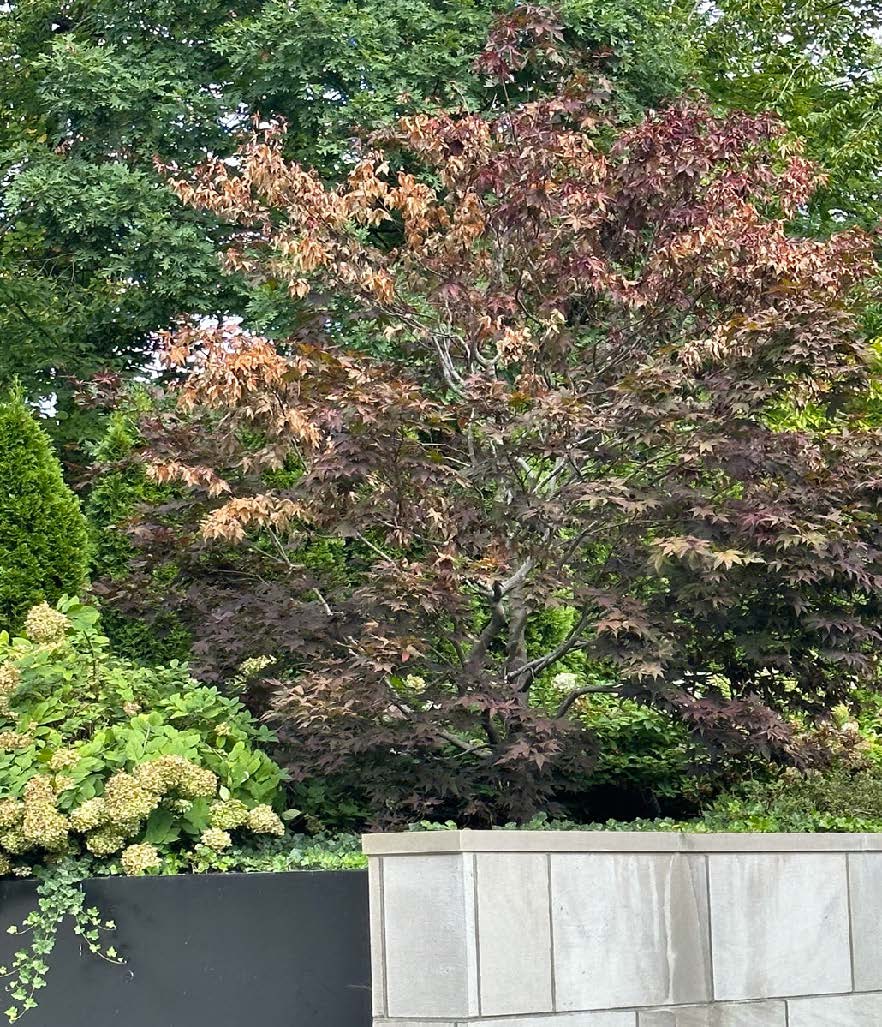Verticillium Wilt of Shade Trees
ID
450-619 (SPES-571NP)
Introduction
Verticillium wilt is a serious vascular wilt disease affecting many shade tree species and over 80 tree genera, as well as many woody ornamental landscape plants, and herbaceous and vegetable plants. Verticillium wilt most commonly occurs in nursery, orchard and landscape locations. Maple (Acer spp.) are a tree genus commonly associated with the disease, but Verticillium wilt occurs on many other trees and woody ornamentals used in landscapes. Verticillium wilt more commonly occurs in locations with colder climates than Virginia; however, Verticillium wilt does cause disease on trees and woody ornamentals in Virginia.
The Pathogen
Two soilborne fungi, Verticillium alboatrum and Verticillium dahliae, can cause Verticillium wilt, but in North America, V. dahliae is the most common cause of the disease. The Verticillium pathogen infects trees via roots and can become systemic in the tree by traveling in the sap as it flows upward in the tree. This leads to fungal colonization of the vascular (water- and nutrient- conducting) tissue, causing tissue death and failure of the tissue to transport water and nutrients in the tree.
Both V. dahlia and V. alboatrum produce survival structures in the soil that persist and can cause new infections in healthy host plants.
Symptoms
Symptoms of Verticillium wilt include wilted, shriveled, scorched or browning leaves; off-color foliage; stunting; defoliation; dieback and death (figures 1-3). Symptoms may occur only on part of the tree, such as an individual branch or branches (figure 4), or occur on the whole tree (figure 5). Young trees are more likely to decline rapidly compared to mature trees, which are typically slow in progression of dieback (figure 6). Symptoms of Verticillium wilt may be more pronounced in one year than another.





Internal symptoms of Verticillium wilt may be visible in a cross-section of symptomatic branches (or the main stem or trunk) (figure 6). These appear as a dark discoloration of the sapwood (woody tissue just beneath the bark) (figure 7) or deeper vascular tissue within the branch or trunk or main stem. The discoloration may be apparent in cross-sections of branches or main stems as discolored ring(s) or arc(s) in the vascular tissue, which follow the pattern of growth rings (figure 8). Discolored vascular tissue will not occur uniformly throughout a Verticillium-diseased tree and the color of the discoloration may vary (e.g. gray-green, green, reddish-brown, light tan, etc.) by tree species. Recently infected trees may not show any discoloration and some tree species, such as Fraxinus pennsylvanica (green ash), rarely develop discoloration in the vascular tissue or sapwood. Locating discoloration in the vascular tissue is helpful for diagnostic purposes and it may take some time to find such locations on a tree, but the best approach is to cut cross-sections through symptomatic branches.



Management
Stressed trees are more susceptible to Verticillium wilt than trees not subjected to stress (e.g. compacted soil conditions, drought, etc.). Stressed trees will also generally succumb more quickly to Verticillium wilt than non-stressed trees, so ensuring optimal cultural conditions and minimizing environmental stress is recommended. Do not apply excessive nitrogen fertilizer and apply fertilizer only as recommended by a soil test.
There is no cure for Verticillium-infected trees and woody ornamentals. Since the disease may cause significant dieback, decline, and death, the use of Verticillium wilt-resistant trees or woody ornamentals is recommended in locations where the disease has been diagnosed.
For Verticillium-diseased trees showing relatively minor symptoms (e.g. little impact to the overall crown of the tree, few symptomatic branches), ensuring adequate irrigation throughout the growing season may slow the progression of the disease. Prune out any dead branches back to healthy tissue and disinfest pruning tools between cuts using 10% household bleach solution or a commercial disinfectant. Remove pruned branches from the location (i.e. destroy or place in the landfill).
Trees with significant dieback should be removed. Verticillium-infected wood should not be chipped for mulch or composted. Be aware that the Verticillium pathogens are soilborne and can be moved to new locations via movement of infested soil or wood, including wood chips or hardwood mulch, and via equipment or tools contaminated with infested soil.
Therefore, in locations where Verticillium wilt has been diagnosed, planting Verticillium-resistant or immune trees or woody ornamentals is strongly recommended (table 1). Gymnosperms (e.g. conifer trees, cycads, and Ginkgo) are immune or resistant to Verticillium wilt.
Many dicots (i.e. flowering trees) are susceptible to Verticillium wilt (table 2); however, some dicots are resistant to the disease (table 1).
Common |
Genus |
|---|---|
Beech |
Fagus |
Birch |
Betula |
Butternut, walnut |
Juglans |
Chestnut |
Castanea |
Dogwood |
Cornus |
Firethorn |
Pyracantha |
Flowering quince |
Chaenoomeles |
Hackberry |
Celtis |
Hawthorn |
Crataegus |
Hickory, pecan |
Carya |
Holly |
Ilex |
Honeylocust |
Gleditsia |
Hornbeam |
Carpinus |
Katsura tree |
Cercidiphyllum |
Mountain ash |
Sorbus |
Mulberry |
Morus |
Planetree, sycamore |
Platanus |
Quince |
Cydonia |
Rhododendron (other than azalea) |
Rhododendron |
Sweetgum |
Liquidambar |
Willow |
Salix |
Zelkova |
Zelkova serrata |
Common Name |
Genus |
|---|---|
Ash |
Fraxinus |
Aucuba |
Aucuba |
Azalea |
Rhododendron |
Barberry |
Berberis |
Buckeye, horse-chestnut |
Aesculus |
Camellia |
Camellia |
Catalpa |
Catalpa |
Cherry, plum, ornamental cherry & plum |
Prunus |
Coffeetree |
Gymnocladus |
Elderberry |
Sambucus |
Elm |
Ulmus |
English ivy |
Hedera |
Fig |
Ficus |
Fringe tree |
Chionanthus |
Golden-rain tree |
Koelreuteria |
Grapevine |
Vitis |
Hibiscus |
Hibiscus |
Horse chestnut |
Aesculus |
Japanese pagoda tree |
Styphnolobium |
Lilac |
Syringa |
Linden |
Tilia |
Locust |
Robinia |
Magnolia |
Magnolia |
Maple, boxelder |
Acer |
Mimosa |
Albizia |
Nandina |
Nandina |
Osage orange |
Maclura |
Osmanthus |
Osmanthus |
Pear and ornamental pear |
Pyrus |
Persimmon |
Diospyros |
Photinia |
Photinia |
Pittosporum |
Pittosporum |
Privet |
Ligustrum |
Redbud |
Cercis |
Rose |
Rosa |
Russian olive |
Elaeagnus |
Sassafras |
Sassafras |
Serviceberry |
Amelanchier |
Smoketree |
Cotinus |
Spiraea |
Spiraea |
Sumac |
Rhus |
Tree of heaven |
Ailanthus |
Tuliptree |
Liriodendron |
Tupelo |
Nyssa |
Viburnum |
Viburnum |
Walnut |
Juglans |
Weigela |
Weigela |
Yellowwood |
Cladrastis |
1 Genera that have been reported as both resistant and susceptible to Verticillium wilt have intentionally been omitted from tables 1 and 2. This situation could occur as a result of variation in virulence of Verticillium isolates, environmental factors and/or genetic variation among species/cultivars/individuals in genera.
Diagnosing the Disease
The Virginia Tech Plant Disease Clinic can diagnose this disease and other plant diseases. Refer to the Plant Disease Clinic website (https://bit.ly/VTplantclinic) for the current diagnostic form, fees, and instructions on collecting an appropriate diagnostic sample and submitting samples to the Plant Disease Clinic. For diagnosis of vascular diseases, it is best to submit several branch samples that show vascular discoloration; however, do not remove all the bark from such samples—that must be removed in the diagnostic lab just before culture assays are performed. Also include branches with leaves that show foliar symptoms.
Completely dead branches are not useful for diagnosis, nor are completely healthy branches.
References
Berlanger, I. and M.L. Powelson. 2000. Verticillium wilt. The Plant Health Instructor. DOI: 10.1094/ PHI-I-2000-0801-01. Accessed 11/30/23 https:// www.apsnet.org/edcenter/disandpath/fungalasco/pdlessons/Pages/VerticilliumWilt.aspx
Sinclair, W.A. and H.H. Lyon. 2005. Diseases of Trees and Shrubs, 2nd ed. Ithaca, N.Y.: Cornell University Press.

Scan to Visit the Plant Disease Clinic Website
Virginia Cooperative Extension materials are available for public use, reprint, or citation without further permission, provided the use includes credit to the author and to Virginia Cooperative Extension, Virginia Tech, and Virginia State University.
Virginia Cooperative Extension is a partnership of Virginia Tech, Virginia State University, the U.S. Department of Agriculture, and local governments. Its programs and employment are open to all, regardless of age, color, disability, sex (including pregnancy), gender, gender identity, gender expression, national origin, political affiliation, race, religion, sexual orientation, genetic information, military status, or any other basis protected by law
Publication Date
February 29, 2024



